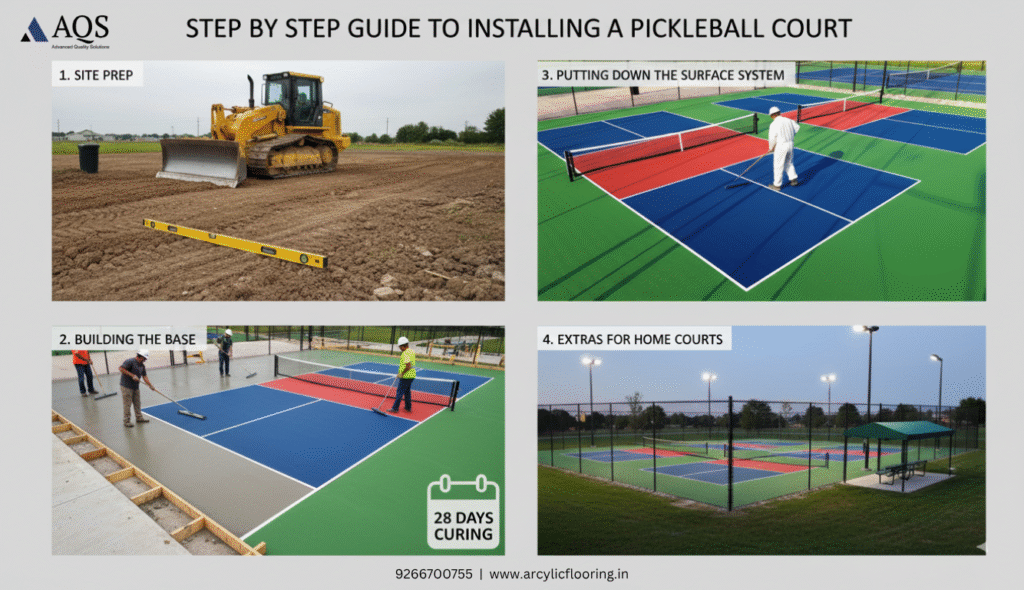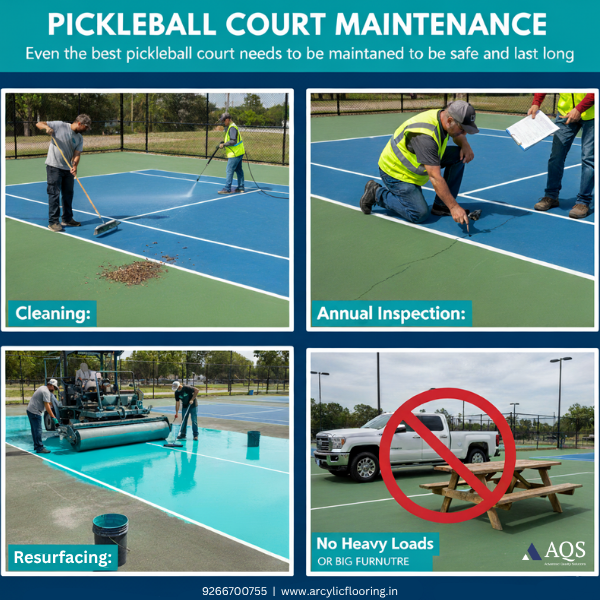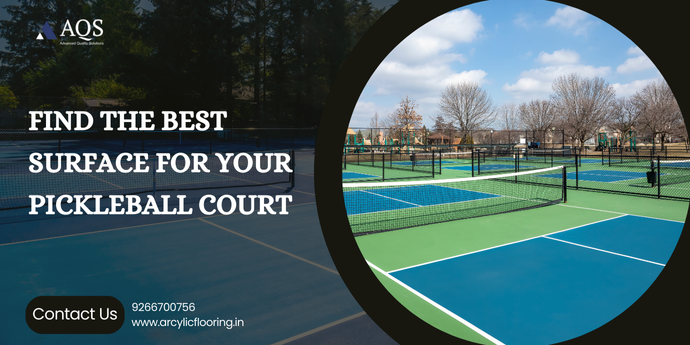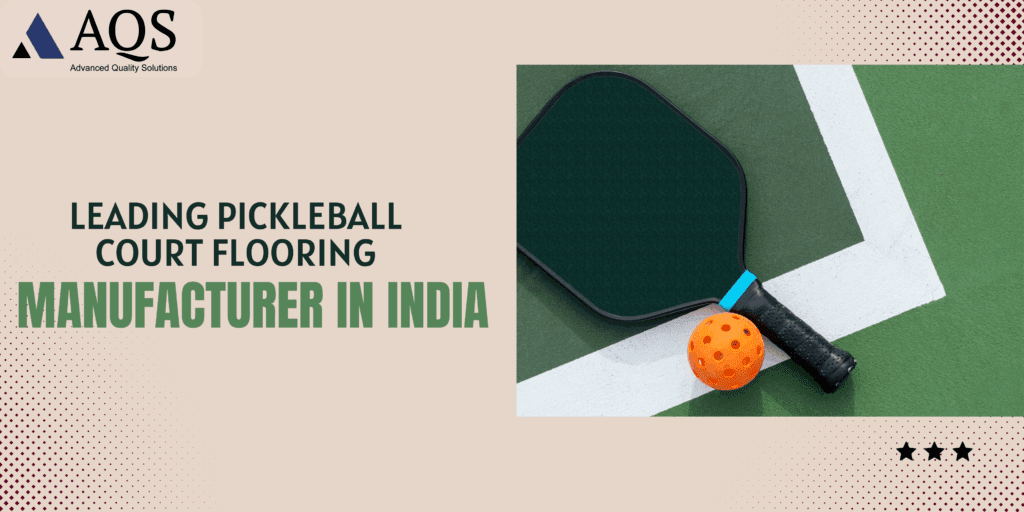Pickleball was a niche game and now it’s one of the fastest growing sports globally including in India. With a mix of tennis, badminton and table tennis pickleball is easy to learn yet highly addictive and attracts players of all ages. Today families, fitness enthusiasts and housing societies are looking for a pickleball court near me as the demand for dedicated play spaces is increasing. Many professional pickleball court construction companies in India are now offering complete solutions from base preparation to pickleball court flooring with international standard acrylic materials. So a home pickleball court doesn’t just look like a play area but performs like a professional sports facility.
In this blog we will cover everything you need to know about pickleball construction at home: the exact dimensions, pickleball court cost to build, materials used, step by step installation and why expert pickleball court contractors are the key to building long lasting and safe courts. By the end of this you will have a clear roadmap to turn your backyard into a professional quality pickleball court.
Pickleball Court Dimensions & Home Space Planning
When building a home pickleball court, your first step is to get a grasp on the officially sanctioned court size, then figure out how to fit that into the backyard or residential property you’ve got to work with. You want to do your planning right so that it not only flows beautifully but also holds up long-term
- Pickleball Court Size: are 20 ft wide & 44 ft long – the doubles play standard.
These dimensions have been accepted internationally, ensuring consistency in gameplay, proper bounce, and fair play whether you’re just messing around or having a match. - Minimum Clearance Needed: 30 ft × 60 ft is for extra play space.
Having some room around the court lets players run wild, minimizes the risk of accidents and is pretty much a must have for safe, fun play – whether that’s a group of buddies having a blast or serious competitive action. - Backyard Courts & Space Adjustments:
Even if you are reducing the court size to fit into your backyard you can still keep the space on either side and at the back wide enough so that people can move freely and don’t get hurt – a big consideration for just about any kind of pickleball play.
Picking the Perfect Surface for Your Pickleball Court
Picking the right surface for a pickleball court is a bit of a no-brainer – it’s the make or break factor when it comes to getting a consistent bounce, keeping players safe, and making sure your court doesn’t fall apart underfoot. A good floor is the difference between a fun and frustrating game of pickleball.
The Most Popular Options for Pickleball Court Surfaces:
1. Concrete and Acrylic Flooring – The Top Pick For Outdoors
- The holy grail of outdoor pickleball court surfaces, and for good reason. This combination is as solid as it gets and will keep your court looking brand new for years to come.
- We love it because it’s low maintenance, it doesn’t get damaged by UV light, and it can handle even the heaviest monsoons, so whether you’re playing in the blistering heat of an Indian summer or the torrential rains of the same, your court will stay in top nick.
2. Asphalt and Acrylic Flooring – A Budget-Friendly Option
- For those with a smaller budget, a great value option that still delivers on playability.
- But be aware, if you don’t get the slope and drainage just right, you’ll end up with a patchwork of cracks and costly repairs.
3. Temporary Pickleball Flooring – Perfect For Multi-Purpose Spaces
- If you need to be able to chop and change your court to suit different activities, these modular surfaces are your best bet.
- They’re easy to set up and take down, but they just can’t hold a candle to the durability and lifespan of a proper acrylic system – for long term use, either at home or in a professional setting, you can’t go wrong with the gold standard of acrylic pickleball floorings.
Step by Step Guide to Installing a Pickleball Court
1. Site Prep
- Clearing the land, compacting the soil and getting the ground level: We clear the site of any debris, compact the soil to create a solid base and get it level – nowhere for water to collect or the surface to shift.
- Design a slight slope to take care of drainage (1:100): so if it rains a bit, the water just rolls off rather than pooling and causing problems
2. Building the Base
- Laying the concrete base (a 100-125 mm thick RCC slab that needs 28 days of curing time): if you do it right and let it cure properly, this is a base that will last a long time and not crack or shift.
- Laying asphalt (50-75 mm thick, compacted with a roller): a bit cheaper then concrete but you need to get the compacting right, any air pockets can cause cracks and unevenness
3. Putting Down the Surface System
Professional pickleball court installers do the job, putting down a multi-layer acrylic system to make the court durable and fun to play on
- A primer coat to help the base and surface stick together: we just want to make sure the base and surface stick together properly, no peeling or coming apart
- A resurfacer coat to fill in the pores and smooth out the surface: this bit helps get the surface nice and even, no bumps or rough bits
- Cushion layers (if you want them): adds a bit of comfort for your joints and a softer hit – handy if you play a game a lot
- Colour coats: make the colour of the surface look nice, add a bit of UV stability and slip resistance so you can play in safety
- Line markings to keep the game going: standard rules, so singles and doubles we got you covered.
4. Extras for Home Courts
- Fencing to keep the balls in (10-12 ft chain link): keeps the balls from going over the edge and ensures everyone stays safe.
- Good lighting (LED flood lights) so we can play at night: saves energy and makes sure everyone can see what they are doing.
- Some nice seats and shade (a little bench or something): because players should be able to take a rest from time to time, have a chat with mates or sit quietly and watch.

Cost of Building a Home Pickleball Court
The pickleball court build cost depends on base type, material system, and additional features.
| Component | Estimated Cost Range (₹) |
| Base Layer (Concrete/Asphalt) | 8–9 lakh |
| Pickleball Court Material (5-layer system) | 4–5 lakh |
| Advanced 8-layer Cushion System | 6 lakh |
| Labor & Installation | 2–3 lakh |
| Optional Features (Fencing, Lighting) | 3–5 lakh |
| Total Pickleball Court Cost to Build | 14–18 lakh |
For smaller backyard setups, costs can be optimized by reducing fencing height, choosing a 5-layer acrylic system, or skipping lighting initially.
The Great Pickleball Court – DIY or Professional Help
Some home owners tempted to take on building a pickleball court from scratch are seriously underestimating the risks of a DIY job – it could spell disaster for your court’s longevity and overall playability:
- Slope of Despair: Get the slope wrong and you’ll be chasing after raindrops every time the skies open up – your court will be no more than a waterlogged mess.
- Mixing Up a Recipe for Disaster: Get the primer, cushion and color coats mixed up and you’re basically weakening the bond and reducing the lifespan of the flooring.
- The Uneven Application Blues: Try to get it even and you’ll probably end up with patches all over the place, leaving players struggling with a ball that doesn’t bounce right and surfaces that are far from safe.
But then there are the pickleball court specialists – they deliver results that are reliable, top-notch and performance-driven:
- Acrylic flooring: They use the top-rated coatings that are ITF-approved and will give you the consistency and safety you want for international level play.
- Base preparation to remove Cracks: Proper compaction, expansion joints and drainage systems are all part of the package, so you can say goodbye to cracks and surface failures.
- Curing, Sealing and Marking: the Pickleball Way: Every stage is executed to perfection from getting the base right to putting in the accurate line markings for singles and doubles play.
- Warranty: When you hire the pros, you get a long-term warranty thrown in – so you can relax and enjoy your court without breaking the bank on maintenance costs down the line.
By hiring a team of experienced pickleball court experts, you get a pickleball court that doesn’t just look the part but also delivers on performance and durability.
Pickleball Court Maintenance
Even the best pickleball court needs to be maintained to be safe and last long.
- Cleaning: Sweep and wash often to stop dust, moss and debris from building up and making the surface slippery and unsafe to play on.
- Annual Inspection: Get an annual check to catch cracks, slope issues or surface wear before they become major repairs.
- Resurfacing: Apply a new acrylic coat every 3-5 years to restore grip, bounce and color and keep the pickleball court performance ready.
- No Heavy Loads: Do not put vehicles or big furniture pieces on the surface – it’s just too stressful for the flooring layers, and will cut down the lifespan.
A well-maintained pickleball court system will last around 5 to 7 years with only the occasional minor tweak to keep things running smoothly. Players will have consistent play, and you won’t have to worry about replacing the flooring any time soon.

Benefits of a Home Pickleball Court
1. A Great Way to Meet New People
Having a home pickleball court is like having a social hub at your place – family, friends and the neighbors can hang out there, making it a fantastic spot for everyone to get together and have some fun, while also staying active.
2. Long Term Value
Installing a pickleball court at your place will definitely increase the value of your property and its resale value too. If you’re in a residential complex or private villa it really sets you apart from the crowd with its premium recreational facilities.
3. Keep Fit & Relaxed
Pickleball courts are basically a great cardio workout, they’ll also improve your agility and balance. It’s a full body workout that anyone, regardless of age, can do – and regular play will keep you fit, reduce stress and even improve your mental wellbeing.
4. Save a Buck
Having your own private pickleball court means no more renting out club facilities and paying those membership fees. In the long run it’ll actually save you money and give you unlimited access to play whenever you want, nice and conveniently.
Environmental & Economic Benefits of Acrylic Pickleball Court Surface
Modern pickleball court surfaces like acrylic are really eco-friendly and cost effective in the long run:
- Low VOC Emissions: We’re talking about an acrylic surface here, which uses really low volatile organic compounds – much safer for players and the environment than those older surfaces.
- Built to Last: High UV, moisture and crack resistance means you don’t have to resurface or replace the flooring as often – less hassle, less cost.
- Energy Efficient: Quick dry chemistry is a big plus – it means less water and power consumption during installation, and it’s all done in a flash, so you save on operational costs.
So, in the end, a synthetic pickleball court is not only affordable, but it’s also sustainable and meets international standards.
Conclusion
Building a home pickleball court is more than just building a court. It’s an investment in your lifestyle, your fitness and your community. With the right pickleball court surface, planning and a professional pickleball court builder. You can get international standard quality at your doorstep.
Ultimately a home pickleball court is a long term lifestyle upgrade. It’s not just a bit of exercise, it’s a whole family dream. You can spend quality time with the grandkids, train for games and live a healthy active life together. So, if you’re ready to make the investment, just be sure to get some expert advice from a professional pickleball court construction company that specializes in residential builds. With their help, your home can be the hub of recreation, fitness and modern living – and your new pickleball court the real crown jewel.
Frequently Asked Questions
A standard court is 20 × 44 ft, with 30 × 60 ft recommended including safety zones.
The pickleball court cost to build is between ₹14–18 lakh for a standard court.
Acrylic flooring over concrete base is the most durable and weather-resistant option.
Yes, compact versions can built depending on available space.
Yes, because slope, base curing, and correct layering require expertise.
With proper care 4–7 years before resurfacing.
Primer, resurfacer, cushion coats, acrylic color coats, and line paint.




